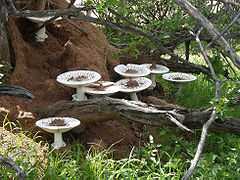Termitomyces
| Termitomyces | |
|---|---|
 | |
| Termitomyces reticulatus | |
| Scientific classification | |
| Kingdom: | Fungi |
| Division: | Basidiomycota |
| Class: | Basidiomycetes |
| Order: | Agaricales |
| Family: | Lyophyllaceae |
| Genus: | Termitomyces R.Heim |
| Type species | |
| Termitomyces striatus (Beeli) R.Heim | |
| Synonyms[1] | |
|
1945 Podabrella Singer | |
Termitomyces is a genus of basidiomycete fungi belonging to the family Lyophyllaceae. There are about 30 species in the genus.[2] They are the food source for a subfamily of termites, the Macrotermitinae, who enjoy an obligate symbiosis with the genus similar to that between Atta ants and Attamyces mushrooms. Despite this relationship, spore transfer is still accomplished mainly by shedding from mushrooms, which protrude from the termite mounds.[3]
Characteristics
These mushrooms are edible for most people, and the larger species are a popular wild food where they occur. They include the largest mushroom in the world, Termitomyces titanicus of West Africa, whose cap reaches 1 metre (3 ft) in diameter. These fungi grow on 'combs' which are excreta from the termites, dominated by tough woody fragments. Termitomyces was circumscribed by Roger Heim in 1942.[4]
From 1955 to 1969 Arthur French [5] worked in Uganda (as a hobby) on the subject of fungi and termites. Some scientific literature, but it dealt inadequately with the relationship between mushrooms and termites, while the most edible varieties were 'termite mushrooms'. French conducted some investigations with the help of the elderly Baganda women who gathered them, and published the results. For a year or two he was a world expert on termite mushrooms.
Species
- Termitomyces aurantiacus
- Termitomyces bulborhizus
- Termitomyces clypeatus
- Termitomyces eurhizus
- Termitomyces globulus
- Termitomyces heimii
- Termitomyces le-testui
- Termitomyces mammiformis
- Termitomyces microcarpus
- Termitomyces reticulatus
- Termitomyces robustus
- Termitomyces sagittiformis
- Termitomyces schimperi
- Termitomyces striatus
- Termitomyces titanicus
- Termitomyces tylerianus
- Termitomyces umkowaani
See also
- Inedible Podaxis, which may also grow from termitaria
References
- ↑ "Termitomyces R. Heim 1942". MycoBank. International Mycological Association. Retrieved 2010-12-23.
- ↑ Kirk PM, Cannon PF, Minter DW, Stalpers JA. (2008). Dictionary of the Fungi (10th ed.). Wallingford, UK: CABI. p. 682. ISBN 0-85199-826-7.
- ↑ Mueller, U. G.; Gerardo, N. M.; Aanen, D. K.; Six, D. L.; Schultz, T. R. (2005). "The Evolution of Agriculture in Insects". Annual Review of Ecology, Evolution, and Systematics 36: 563. doi:10.1146/annurev.ecolsys.36.102003.152626.
- ↑ Heim R. (1942). "Nouvelles études descriptives sur les agarics termitophiles d'Afrique tropicale". Archives du Muséum National d'Histoire Naturelle (in French) 18 (6): 107–66.
- ↑ French A. (1993). "The Mushroom-Growing Termites of Uganda". Petits Propos Culinaires (44): 35–41.
See Tobias Frøslev's Termitomyces page And an academic review of the relationship in Patterns of interaction specificity of fungus-growing termites and Termitomyces symbionts in South Africa Aanenet DK al BMC Evol Biol. 2007; 7: 115.